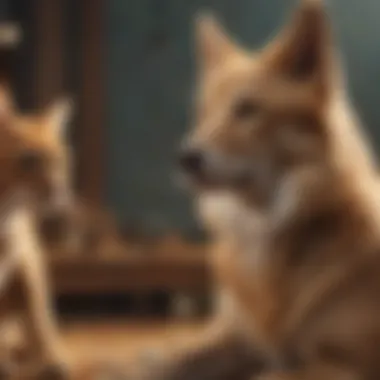Exploring the Intricate Relationship Dynamics Between Dogs and Cats


Animal Species Profile
Dogs and cats, although often portrayed as eternal foes, share a complex and fascinating relationship that has captivated animal lovers worldwide. Dogs, known for their loyalty and affectionate nature, contrast with the independent and mysterious demeanor of cats. While dogs exhibit a wide range of breeds with diverse physical characteristics from small Chihuahuas to large Great Danes, cats display elegant features and an innate agility suited for their hunting instincts. In their natural habitats, dogs have historically thrived in packs, displaying social hierarchies and cooperation, while cats, solitary hunters by nature, prefer a more independent lifestyle. Understanding their social behaviors from playfulness to aggression sheds light on the nuances of their interactions.
Conservation & Wildlife Efforts
As domesticated animals, dogs and cats are not typically subjects of conservation efforts. However, in the wild, specific dog and cat species face threats to their populations due to habitat destruction, poaching, and disease. Conservation initiatives led by organizations aim to protect wild dog and cat populations by creating awareness, enforcing wildlife protection laws, and establishing protected areas. Success stories in reintroducing endangered species into the wild highlight the positive impact of conservation efforts in safeguarding these charismatic predators.
Animal Behavior & Psychology
The communication styles of dogs and cats differ significantly, with dogs relying on vocalizations, body language, and facial expressions, while cats communicate through vocalizations, scent marking, and subtle body cues. Reproductive behavior varies between the two species, with dogs exhibiting pack-oriented mating rituals and parental care, whereas cats are solitary breeders with minimal parental involvement. Cognitive studies have shown that both dogs and cats possess problem-solving skills, but dogs tend to excel in tasks requiring social cognition, while cats exhibit strategic thinking and independence in problem-solving. Emotional intelligence in dogs is reflected in their ability to empathize with human emotions, while cats display a more enigmatic yet affectionate demeanor in their social dynamics.
Unique Facts & Trivia
Did you know that dogs have a sense of time and can anticipate their owners' routines? Cats, on the other hand, have a remarkable ability to always land on their feet due to their flexible backbones and inner ear balance. Fun trivia includes the fact that the world's smallest dog breed is the Chihuahua, while Maine Coon cats hold the title for the largest domestic cat breed. Dogs have been known to perform astonishing feats such as detecting medical conditions like seizures and cancers, while cats showcase agility and athleticism in their acrobatic movements.
Pet Care & Tips
Selecting a pet that matches your lifestyle is crucial. If you lead an active life, a dog that enjoys exercise and companionship might be ideal, while a more reserved owner may find a cat's independence a better fit. Providing proper care, such as regular grooming, nutritious diets, and veterinary check-ups, ensures the well-being and longevity of your pet. Training techniques tailored to the personality of your pet, whether dog or cat, can strengthen the human-animal bond and encourage positive behaviors. Offering enrichment activities like puzzle toys for dogs and interactive play for cats promotes mental stimulation and prevents behavioral issues.
Introduction
In this meticulously crafted article, we delve into the intricate dynamics of the interplay between our beloved dogs and cats. By scrutinizing their interactions, behaviors, and shared characteristics, we illuminate the subtle nuances of their coexistence, offering a profound insight into this unique union. From territorial instincts to moments of playful camaraderie, we meticulously unravel the complexities that underpin this fascinating relationship.
Overview of Dogs and Cats


The gist of dogs and cats lies in their contrasting yet complementary traits. Dogs, known for their loyal and sociable nature, stand in stark juxtaposition to the independent and mysterious felines. These defining characteristics become the foundation of their dynamic interplay, shaping their interactions in homes and streets alike. The duality of their personalities elevates the narrative of our discussion, as we explore how these creatures navigate their shared environments with distinct grace and charm.
Defining characteristics of dogs and cats
At the core of understanding the essence of dogs and cats stand their defining characteristics. The loyal and affectionate nature of dogs contrasts with the independent and self-sufficient demeanor of cats. This interplay of companionship and autonomy sets the stage for a myriad of behaviors and interactions that define the fabric of their relationship. The juxtaposition of these characters not only provides depth to our exploration but also sheds light on the fascinating fusion of two contrasting worlds.
Significance of Their Relationship
The historical tapestry woven by dogs and cats reverberates through ages, etching tales of partnership and camaraderie. From ancient civilizations to modern households, their significance transcends mere companionship, evolving into symbols of loyalty and mystique. The impact of their relationship on cultural narratives amplifies the depth of their bond, intertwining tales of valor and companionship that stand the test of time.
Historical context
Deep-rooted in historical contexts, the alliance between dogs and cats bridges vast landscapes of civilization, echoing stories of shared destinies and intertwined paths. Their exquisite dance through history reveals not just interactions but a saga of mutual reliance and understanding, painting a canvas of symbiotic relationships rooted in the annals of time.
Cultural perceptions
Cultural perceptions frame the prism through which we view the relationships of dogs and cats. From revered symbols in Eastern cultures to loyal companions in the Western world, these animals embody diverse meanings that reflect our societal values and beliefs. Their portrayal in art, folklore, and literature enriches our understanding of their roles beyond mere pets, elevating them to emblems of courage, vigilance, and unyielding spirit.
Purpose of the Study
At the crux of our investigation lies the noble pursuit of comprehending the intricate tapestry of behaviors that define the interactions between dogs and cats. Unraveling the threads of their mutual exchanges unveils not just the surface-level dynamics but the deeper undercurrents that dictate their rhythms of coexistence. By peeling back the layers of their interplay, we unearth the hidden gems of understanding that illuminate the path towards enriched companionship.
Understanding mutual behaviors
Exploring the realm of mutual behaviors between dogs and cats unlocks a trove of insights into their subtle language of interaction. From playful nudges to cautious approaches, each gesture speaks volumes about their evolving relationship dynamics. By dissecting these behaviors with a keen eye, we pave the way for a deeper connection with our animal companions, fostering bonds that transcend the boundaries of traditional understanding and embracing the nuances of interspecies communication.
Behavioral Studies


In delving into the intricacies of the relationship between dogs and cats, the section on Behavioral Studies stands as a crucial pillar. This segment serves as a meticulous examination of the behaviors exhibited by these animals, shedding light on their interactions and responses in various contexts. By dissecting their behavioral patterns, we unearth a deeper comprehension of the dynamics between dogs and cats, unraveling the layers of complexity that define their coexistence. Through Behavioral Studies, we not only observe surface-level actions but also decipher the underlying motives and intricacies that govern the interactions between these two species.
Territorial Dynamics
In the realm of animal behavior, Territorial Dynamics play a pivotal role in shaping the relationships between dogs and cats. Within this domain, one specific aspect that demands attention is Territorial marking behaviors. These behaviors encompass the marking of specific areas by animals to assert ownership and demarcate territory. By exploring the nuances of Territorial marking behaviors, we gain insight into how dogs and cats navigate and establish their spaces, thereby influencing their cohabitation dynamics. The unique characteristic of Territorial marking behaviors lies in its innate instinctual nature, serving as a primordial method of communication and assertion for these animals. This behavior choice proves crucial in understanding territorial disputes, social hierarchies, and territoriality-related conflicts, making it a prominent focal point for analysis within this article.
Communication Methods
Another significant aspect under Behavioral Studies is the examination of Communication Methods employed by dogs and cats. Vocalizations stand out as a primary mode of communication, enabling these animals to express emotions, convey intent, and establish connections with one another. The key characteristic of Vocalizations lies in its diverse range, incorporating barks, meows, growls, and purrs, each carrying distinct meanings and nuances. This choice of communication proves beneficial in illustrating the emotional states, needs, and warnings expressed by these animals, enriching the depth of their interactions. Additionally, Body language cues constitute a vital component of their communication repertoire, encompassing gestures, postures, and expressions that convey a wealth of information non-verbally. The unique feature of Body language cues lies in its universal nature, transcending language barriers and serving as a fundamental tool for maintaining social harmony and resolving conflicts among dogs and cats.
Playful Interactions
Delving deeper into the realm of Behavioral Studies unveils the dynamic facet of Playful Interactions between dogs and cats. Mutual play behaviors emerge as a key aspect that fosters bonding, relieves stress, and enables socialization among these animals. The key characteristic of Mutual play behaviors is the reciprocal nature of engagement, where dogs and cats partake in shared activities that strengthen their relationship and promote physical and mental well-being. This choice of interactive play proves popular among these animals, fostering companionship, agility, and cognitive stimulation. The unique feature of Mutual play behaviors lies in its role in mitigating conflicts, instilling trust, and fostering camaraderie between dogs and cats, facilitating positive interactions and enriching their overall relationship within the context of this article.
Common Traits
In delving deep into the intricate world of the relationship between dogs and cats, understanding their common traits emerges as a pivotal aspect of this discourse. The commonalities shared between these two distinct animal companions offer a profound insight into the ways they navigate their coexistence. From social hierarchies to hunting instincts, exploring these shared traits unravels the underlying dynamics of their intricate bond. Shedding light on these common traits not only provides a deeper understanding of their behaviors but also showcases the complexities embedded within their relationship.
Social Hierarchies
Dominance dynamics
Within the realm of social hierarchies, the concept of dominance dynamics plays a significant role in shaping the interactions between dogs and cats. This particular aspect delves into the power dynamics and leadership structures that are prevalent within their social frameworks. Understanding the key characteristic of dominance dynamics illuminates the roles each animal assumes within their relationship, establishing patterns of behavior that dictate their interactions. The unique feature of dominance dynamics lies in its influence on decision-making processes and conflict resolution, offering insights into how these animals establish order and structure within their shared environment. Exploring the advantages and disadvantages of dominance dynamics provides valuable insights into the intricate balance of power and authority that defines the nuances of their bond.
Hunting Instincts


Predatory behaviors
In unraveling the layers of hunting instincts present in both dogs and cats, the focus shifts towards examining their predatory behaviors. This specific aspect delves into the primal instincts and survival mechanisms that drive their hunting prowess. Highlighting the key characteristics of predatory behaviors sheds light on the hunting strategies employed by these animals, showcasing their adaptations to capture prey efficiently. The unique feature of predatory behaviors lies in their innate hunting skills and techniques, honed through generations of evolution. Understanding the advantages and disadvantages of predatory behaviors offers insights into how these instincts shape their behavior patterns and play a crucial role in their cohabitation.
Bonding Mechanisms
Factors that promote bonding
Exploring the intricate web of bonding mechanisms shared between dogs and cats unveils the mechanisms that foster companionship and mutual understanding. The specific aspect of factors that promote bonding illuminates the subtle cues and behaviors that contribute to the development of strong emotional connections between these animals. Highlighting the key characteristic of factors that promote bonding showcases the importance of trust, respect, and shared experiences in nurturing their relationship. The unique feature of these bonding mechanisms lies in their ability to bridge communication gaps and establish a sense of camaraderie that transcends species boundaries. Describing the advantages and disadvantages of factors that promote bonding provides a nuanced view of the intricacies that shape the emotional bonds and dynamics between dogs and cats.
Comparative Analysis
Dog vs. Cat Relationships
Contrasting behaviors
The focal point of contrasting behaviors between dogs and cats unveils a tapestry of distinctive traits that shape their interactions and relationships. Dogs, known for their exuberant loyalty and expressive demeanor, stand in contrast to the enigmatic independence and grace of cats. This dichotomy in behavior not only colors their interactions but also forms the bedrock of their companionship with humans. The key characteristic of contrasting behaviors lies in the fundamental divergences in evolutionary traits that have sculpted the behavioral patterns of these animals over millennia. For this article, delving into the unique traits that set dogs and cats apart serves to highlight the underlying factors that dictate their responses to stimuli and their roles within the shared household setting. Understanding these contrasting behaviors is essential for pet owners and enthusiasts seeking to foster harmonious relationships between these two distinct yet endearing creatures. By appreciating the benefits of each behavioral style, individuals can navigate the intricacies of pet companionship with grace and insight.
Evolutionary Perspectives
Adaptations in domestication
A critical exploration within the realm of evolutionary perspectives is to dissect the adaptations that have unfolded through the process of domestication for both dogs and cats. Understanding the key role that domestication has played in shaping the physical, behavioral, and cognitive attributes of these species is integral to comprehending their positions in modern human society. The key characteristic of adaptations in domestication lies in the dynamic interplay between genetic predispositions and environmental influences, culminating in the diverse array of breeds and behaviors we observe today. By delving into these adaptations, we illuminate the pathways that have led dogs and cats from their wild ancestry to their current roles as cherished companions. This discussion serves to underscore the significance of historical contexts in shaping the evolutionary trajectories of these animals, offering a lens through which to appreciate the intricate tapestry of coevolution between humans and their animal counterparts.
Psychological Insights
Impact on human-animal interactions
At the crossroads of psychology and animal behavior lies the profound impact that dogs and cats wield on human-animal interactions. This nuanced aspect delves into the realms of emotional connection, cognitive empathy, and therapeutic benefits that these animals offer to their human counterparts. The key characteristic of this impact lies in the reciprocal nature of the bond shared between humans and their canine and feline companions, offering mutual understanding and support. For this article, exploring the psychological insights into these relationships underscores the need to acknowledge the emotional depth and symbiotic dynamics at play. By recognizing the advantages of such interactions, individuals can cultivate enriching relationships with their pets, fostering a sense of interconnectedness and well-being that transcends mere companionship. The unique feature of this psychological insight lies in its ability to bridge gaps, heal wounds, and nurture a sense of belonging that resonates with animal lovers, educators, and pet owners on a profound level.
Conclusion
Dogs and cats, despite their stereotypical differences, exhibit fascinating interdependent behaviors that influence human-animal interactions. The importance of understanding the dynamics of their relationship lies in enhancing cohabitation experiences for pet owners. By delving into their interactions, behaviors, and common traits, pet owners gain valuable insights into promoting a harmonious environment for their furry companions. Recognizing the nuances of their territorial instincts and playful camaraderie enables pet owners to create enriching environments conducive to positive interactions between dogs and cats. The key lies in fostering understanding and respect for each pet's unique needs, ultimately promoting a peaceful coexistence in households. Addressing the implications for pet owners, it becomes evident that enhancing cohabitation experiences involves creating a nurturing environment that accommodates both dogs and cats' inherent traits. This not only benefits the pets themselves but also contributes to the well-being and satisfaction of their human caregivers. The intervention of enhancing cohabitation experiences serves as an adaptable and beneficial practice for pet owners looking to cultivate a balanced environment for their furry companions. Its unique feature lies in its ability to foster mutual respect and understanding between different pets while promoting a sense of security and comfort within the household. This approach offers advantages by reducing potential conflicts and fostering harmonious interactions between dogs and cats, ultimately leading to a happier and more cohesive pet household. Moving forward, exploring uncharted research directions in the relationship between dogs and cats opens up new avenues for understanding pet behavior and human-animal dynamics. Conducting in-depth studies on unexplored areas presents a substantial contribution to enriching our knowledge of these complex relationships. The unexplored avenues for study hold the potential to shed light on undiscovered aspects of the bond between dogs and cats, paving the way for innovative practices in pet care. The key characteristic of these unexplored avenues is their capacity to unveil hidden complexities and intricacies within the interactions of dogs and cats. Their exploration is a compelling choice for this article as it offers a fresh perspective on the dynamics of these relationships, inspiring further research and analysis. Delving into unexplored avenues offers the benefit of expanding our understanding of pet behavior and fostering new insights into the cohabitation dynamics of dogs and cats. Although challenges may arise in navigating these unfamiliar territories, the rewards of gaining a deeper comprehension of the nuanced relationship nuances between dogs and cats are well worth the effort.







